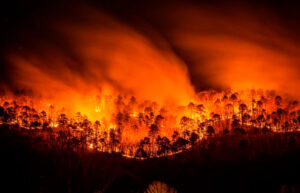 North Carolina Forestry Officials have just declared a State of Emergency due to a rapidly spreading wildfires in Henderson County and Cherokee County that have already consumed thousands of acres, several buildings, and injured at least one firefighter.
North Carolina Forestry Officials have just declared a State of Emergency due to a rapidly spreading wildfires in Henderson County and Cherokee County that have already consumed thousands of acres, several buildings, and injured at least one firefighter.
According to Henderson County officials, the ‘Poplar Drive Fire’ now spans 431 acres (174 hectares). 2 houses, a cabin, and several outbuildings have been completely destroyed and there are now 75 structures in immediate danger of burning.
In Cherokee County, another fire has spread over more than 2,100 acres (850 hectares), according to the U.S. Forest Service.
North Carolina Forestry officials have now issued a burn ban on most Western NC counties, including the Charlotte-area counties of Gaston and Cleveland.
“Several counties in Western North Carolina are currently in a severe drought, and we are seeing wildfire activity increase due to dry conditions. Because dry conditions are expected to continue this burn ban is necessary to reduce the risk of fires starting and spreading quickly. Our top priority is always to protect lives, property and forestland across the state,” said NC Agriculture Commissioner Steve Troxler in a press release. “Even though not all areas of the North Carolina fall under the burn ban, we do encourage extreme caution with any burning as conditions are dry in many areas of the state. We will continue to assess conditions in the coming weeks to determine if we need to expand the burn ban.”
Elsewhere in the U.S., there are reports of unusually high temperatures and dry spells. The Dallas-Fort Worth area has experienced temperatures in the 80s, which is roughly 10 degrees above the seasonal average. This milder weather has also reached the Midwest, with Wichita, Kansas, seeing temperatures nearing 70 degrees Fahrenheit (21 degrees Celsius). However, a cold front is expected to move into the Central and Southern Plains later in the week, which should bring the temperatures back to the seasonal norms.


